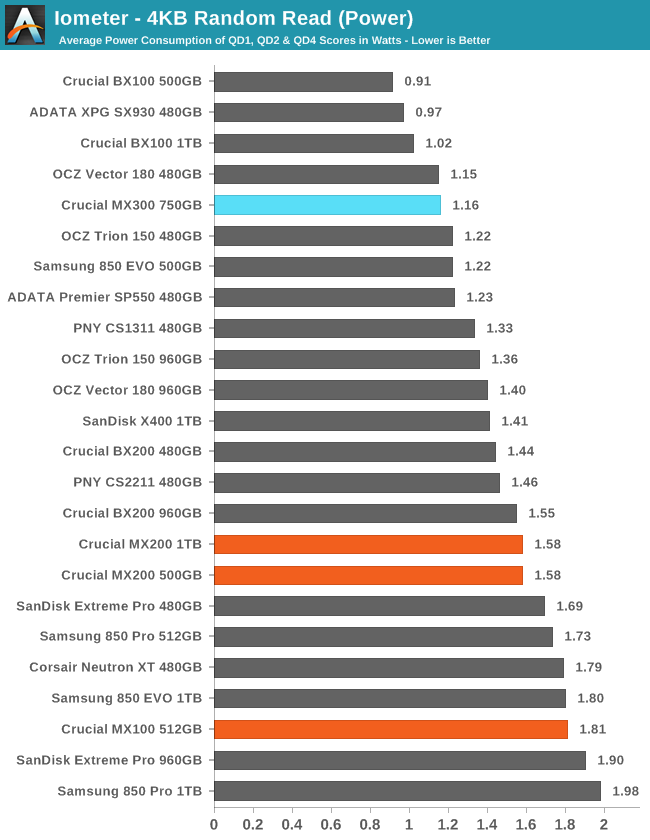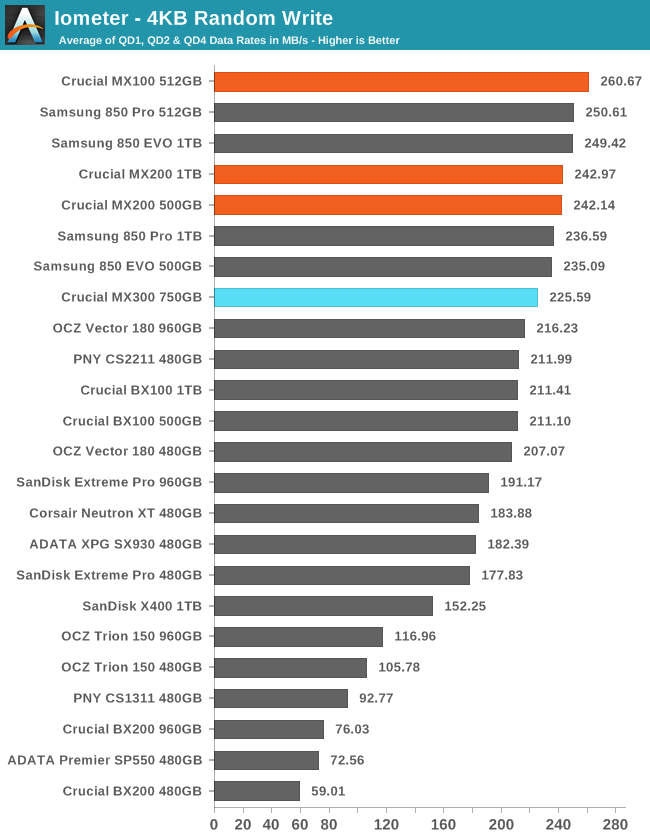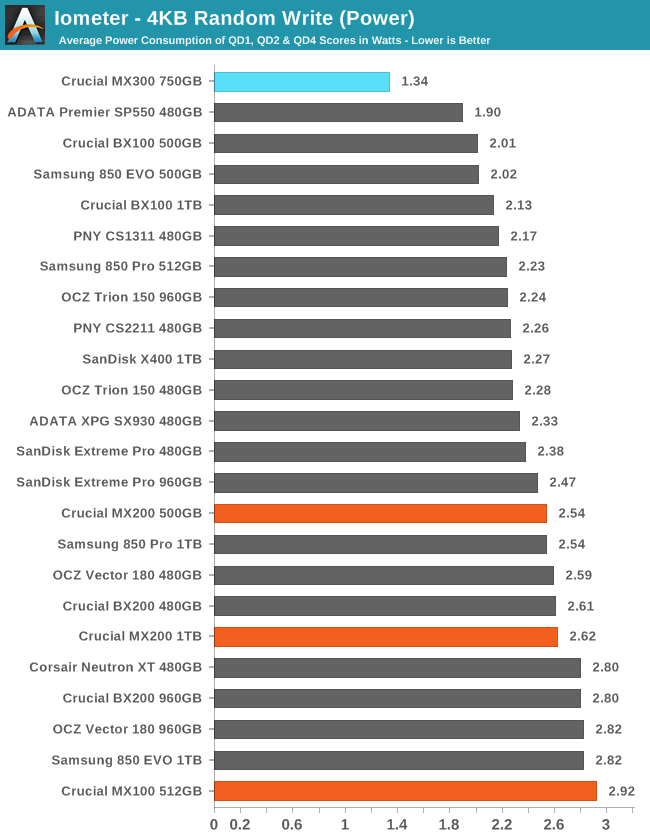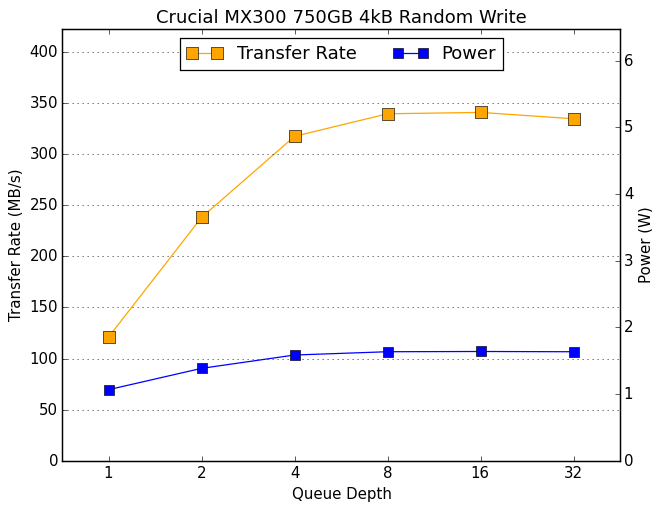The Crucial MX300 750GB SSD Review: Micron's 3D NAND Arrives
by Billy Tallis on June 14, 2016 9:00 AM ESTRandom Read Performance
The random read test requests 4kB blocks and tests queue depths ranging from 1 to 32. The queue depth is doubled every three minutes, for a total test duration of 18 minutes. The test spans the entire drive, which is filled before the test starts. The primary score we report is an average of performances at queue depths 1, 2 and 4, as client usage typically consists mostly of low queue depth operations.

The random read performance of the MX300 is a major regression relative to the MX200, which is a disappointment given that both the SanDisk X400 with planar TLC and the Samsung 850 EVO with 3D TLC manage to perform close to the MX200's level. Since these scores are based on performance at low queue depths of reads that cannot be cached, they reflect an inherently high read latency of Micron's 3D TLC.

Despite the MX300 being close to the top of the power usage chart on this test, the poor performance means that the efficiency is not that great considering.
 |
|||||||||
The MX300's random read performance does increase with queue depth, but not fast enough for it to catch up to the competition or reach a plateau.
Random Write Performance
The random write test writes 4kB blocks and tests queue depths ranging from 1 to 32. The queue depth is doubled every three minutes, for a total test duration of 18 minutes. The test is limited to a 16GB portion of the drive, and the drive is empty save for the 16GB test file. The primary score we report is an average of performances at queue depths 1, 2 and 4, as client usage typically consists mostly of low queue depth operations.

The MX300's random write speed is slightly worse than the MX200, but it is still quite clearly in MLC territory well above the performance level of planar TLC drives.

The MX 300 breaks the power usage record by a shockingly wide margin. Since this average is based on the first 9 minutes of the test, the drive is mostly writing to its SLC cache, which it can apparently do with very little power.
 |
|||||||||
Performance scales very well from QD1 to QD4, but the limit reached by the MX300 is slightly lower than the fastest competitors and there's a slight drop at the end suggesting that the SLC cache began to run out.










85 Comments
View All Comments
euskalzabe - Sunday, June 19, 2016 - link
Excellent reply, bravo.tonyman - Thursday, June 23, 2016 - link
To refute your point that "Nobody Uses SSDs for Cold Storage", I'll give a real-world counterexample... I make a machine vision system that I sell into a factory environment. I build the PCs that the system runs on, and sell it as a turnkey system. For reliability and performance, these PCs are equipped with SSDs as their boot and data drives. As this system, and therefore the PC it runs on, is mission critical, many customers purchase extra preconfigured PCs from us... which can sit around for several years before being used. Data retention on the boot drives of these cold-stored PCs is therefore quite a big issue... one I was ignorant of until a year or so ago, unfortunately. Oops.JKJK - Thursday, June 23, 2016 - link
Raid 0 for storage?Russian rulette ... catch you on the flipside.
sor - Tuesday, June 14, 2016 - link
The MX300 had best in class mixed read/write power performance, and close to the best in other power benchmarks. It seems to beat it's primary competitors (< $.30/GB) on performance, like the OCZ Trion. It could be a better value to make it an obvious buy, but it seems fair to me. It costs less and performs worse than the > $.30/gb range and costs more and performs better than the < $.25/GB.barleyguy - Tuesday, June 14, 2016 - link
"uses more power" isn't accurate. The power usage under load is flat out excellent.Byte - Tuesday, June 14, 2016 - link
Pricing average for 1TB(960GB) is about $200 (you can get ocz trion or silicon power at this price point every day, they are decent mainstream SSDs). This would need to be $150 to even be worth considering. If this had better performance maybe I can see it being worth more. I used a ton of Crucial SSDs and they are fine, but so are pretty much all the other brands i've used. I've only had 1 sandisk low end SSD die on me, and i've handled a few hundred.Gondalf - Wednesday, June 15, 2016 - link
Techreport (and Anandtech) say the contrary and i think they are a lot more reliable than you like hardware testers.TheinsanegamerN - Tuesday, June 14, 2016 - link
More power hungry, worse endurance, slower, and more expensive then the competition. Truly an amazing drive ! /sJoeyJoJo123 - Tuesday, June 14, 2016 - link
Oh no! Less SSD endurance! My current SSD gets winded after only 30 seconds of running! Whatever shall I do with typical consumer I/O workloads and less "endurance"!?[/sarcasm]kyuu - Tuesday, June 14, 2016 - link
Do people even read the article before posting negative crap anymore?It's not more power hungry. In fact, the article shows that it's quite power efficient.
I also hope you're not seriously comparing the MSRP of this drive versus the street prices of other drives. Street prices are always lower than the MSRP, especially in the SSD market.